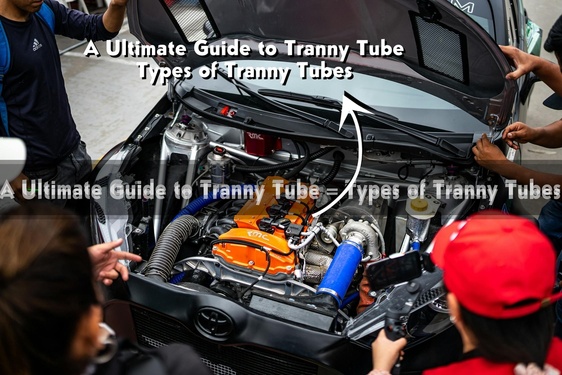Understanding every detail about tranny tubes is essential if you want to maintain and improve your vehicle’s transmission system. This comprehensive guide covers everything from types, features, uses, and benefits to buying tips and safety considerations. Whether you’re a car enthusiast, a mechanic, or just someone looking to understand tranny tubes better, this guide has got you covered.
Introduction to Tranny Tube
A tranny tube, also known as a transmission tube or dipstick tube, plays a vital role in your vehicle’s transmission system. Typically made from durable materials like stainless steel or high-grade plastics, these tubes serve as conduits for transmission fluid and help maintain proper pressure and lubrication inside your transmission.
One of the key components of a tranny tube is its ability to prevent contamination and damage to the torque converter, which is responsible for transferring engine power to the drivetrain. Without a properly functioning tranny tube, your vehicle could face transmission problems, decreased performance, or even costly damage.
Besides functionality, tranny tubes vary in size, flexibility, and material quality, giving car owners many options depending on their vehicle type and driving needs.
Types of Tranny Tubes

Tranny tubes come in different types, each designed to serve specific purposes based on the vehicle’s make, model, and operating conditions. Here are the most common types:
PTFE Tranny Tube
Made from PTFE (Polytetrafluoroethylene), this type of tube is known for its excellent heat resistance, chemical stability, and durability. PTFE tranny tubes are often found in industrial or heavy-duty vehicles that operate under extreme conditions. These tubes resist corrosion and degradation, making them ideal for environments where transmission fluid faces high temperatures or harsh chemicals.
PVC Tranny Tube
PVC tranny tubes are lightweight and affordable, making them popular for lighter cars or budget-friendly repairs. While not as durable as metal options, PVC tubes provide adequate performance for vehicles operating in less demanding conditions. They are also easier to install and replace.
Stainless Steel Tranny Tube
Stainless steel tubes are the most durable and heat-resistant option available. They are corrosion-resistant, ensuring longevity even in harsh weather or extreme driving conditions. Stainless steel tranny tubes are commonly used in heavy trucks, SUVs, and performance vehicles. Their robust construction allows them to withstand physical impact and maintain fluid integrity.
Braided Hose Tranny Tube
These tubes combine flexibility with strength, featuring a stainless steel braided exterior that protects a flexible inner tube. The braided design offers excellent resistance to abrasion, heat, and pressure fluctuations. They’re often preferred for custom builds or racing vehicles.
Flexible Aluminum Tranny Tube
Offering a lightweight yet sturdy option, aluminum tranny tubes provide moderate heat resistance and corrosion protection. They are less flexible than braided hoses but easier to shape and install than steel tubes.
The Purpose of Tranny Tubes
The primary job of a tranny tube is to protect the transmission fluid system and prevent torque converter shudder. This shudder is caused when dirt or debris contaminates the transmission fluid, affecting the torque converter’s ability to function smoothly.
The torque converter is a crucial part of your car’s transmission. It converts the engine’s power into movement through the drivetrain. If it becomes dirty or clogged, you will experience shaking or jerking while driving. A well-maintained tranny tube prevents dirt from entering, ensuring smooth transmission operation.
Additional purposes include:
- Enhancing fluid circulation and lubrication
- Maintaining transmission pressure for optimal performance
- Preventing overheating by allowing fluid to flow properly
- Helping in accurate fluid level monitoring via the dipstick
Features of Tranny Tubes
Modern tranny tubes come with various advanced features to ensure durability and efficiency.
- Schrader Valve: Most high-quality tubes include a corrosion-resistant Schrader valve made from inox steel. This valve allows for safe pressure release and prevents fluid leaks.
- Patent-Pending Sealant: A specialized sealant is applied to prevent dust and moisture from entering, which can last up to two years with proper care.
- Smooth Inner Lining: The internal surface is designed for minimal friction, ensuring fluid flows smoothly, which enhances the transmission’s performance.
- Heat and Chemical Resistance: Depending on the material, many tubes resist heat, corrosion, and chemical breakdown, which is vital for long-term durability.
- Flexible Designs: Some tubes have flexible sections or braided exteriors to accommodate movement and reduce risk of cracking.
Availability and Where to Buy
Tranny tubes are widely available through various automotive superstores, both physical and online. Shopping online can offer benefits like customer reviews, detailed product specs, discounts, and home delivery.
Popular online platforms include:
- Amazon: Offers a wide range of tranny tubes with user reviews that help you pick the best product for your vehicle.
- Auto Parts Retailers: Stores like AutoZone, Advance Auto Parts, and Napa provide reliable options and expert assistance.
- Specialized Transmission Part Suppliers: For professional-grade or custom applications, specialty shops and online stores provide more specific choices.
Is Fluid Replacement Necessary for Your Car?
Regular transmission fluid replacement is crucial for vehicle health. Transmission fluid lubricates moving parts, cools components, and transfers hydraulic power.
Neglecting fluid replacement can result in:
- Overheating transmission parts
- Increased wear and tear
- Reduced fuel efficiency
- Potential transmission failure
Choose high-quality transmission fluid compatible with your vehicle. Always refer to your owner’s manual or mechanic’s advice for fluid types and replacement intervals.
How to Choose the Proper Tranny Tube
Selecting the right tranny tube depends on your vehicle’s specifications and your driving conditions.
Considerations:
- Size: Match the tube size precisely to your vehicle’s transmission system. Tubes too large or small can cause leaks or improper fluid flow.
- Material: Choose materials based on durability needs. Stainless steel or braided tubes are best for heavy-duty or high-heat environments; PVC might suffice for light usage.
- Flexibility: Consider how much movement or vibration your tube must endure. Flexible or braided tubes help prevent cracking or damage.
- Durability: Synthetic tubes typically last longer and handle heat better than traditional materials.
- Compatibility: Ensure compatibility with your car’s make and model, especially for performance or custom vehicles.
Additional Benefits of Tranny Tubes
Besides protection and fluid control, tranny tubes offer these advantages:
- Prevent Fluid Backflow: Tranny tubes help stop transmission fluid from flowing backward, maintaining system pressure.
- Overheating Protection: By ensuring proper fluid flow, tubes help prevent overheating and pressure buildup in the transmission.
- Extended Transmission Life: Proper lubrication and fluid control reduce wear, extending your transmission’s service life.
- Easy Maintenance: Some tubes allow easier fluid level checks and transmission servicing.
When Is a Tranny Tube Used Most Effectively?
A tranny tube is most effective when your vehicle experiences:
- Harsh Driving Conditions: Rough terrain, dust, or heavy loads can increase dirt and wear, requiring durable tubes.
- High Transmission Temperatures: Long drives, towing, or stop-and-go traffic increase heat and stress on components.
- Old or Worn Transmission Systems: Upgrading or replacing tubes can improve performance in older vehicles.
- Preventative Maintenance: Regular replacement of tubes helps avoid unexpected transmission failures.
Is It Safe to Use Tranny Tubes?

Yes, when made from quality materials and used correctly, tranny tubes are safe and beneficial. Modern tubes come in environmentally friendly materials that resist corrosion and wear while protecting your vehicle.
Important Safety Notes:
- Choose tubes certified for your vehicle and compatible with transmission fluid types.
- Regularly inspect tubes for leaks or damage.
- Buy from reputable manufacturers to ensure quality and safety.
- Use eco-friendly or recycled materials where possible to reduce environmental impact.
Six Most-Used Tranny Tubes Explained
1. 1409KMT TH350 TH400 Transmission Dipstick Tube (Flexible Stainless Steel)
This popular tranny tube features a flexible stainless steel build, suitable for Chevrolet GM TH350 and TH400 transmissions. It resists rust and has a sturdy aluminum handle. Its 75 cm length makes it ideal for easy dipstick access.
Pros: Durable, flexible, excellent compatibility.
Cons: May not show brake fluid levels.
2. Stainless Braided Hose Trans Dipstick for Chevy GM
Constructed from rust-resistant stainless steel with a billet handle, this tube is praised for leak prevention and engine bay compatibility.
Pros: Portable, easy to use, trusted by experts.
Cons: Less flexible than some alternatives.
3. TASAN RACING Flexible Stainless 350 Trans Dipstick
Available in multiple colors, this tube combines excellent flexibility with strong corrosion resistance. It fits Chevrolet and GM models.
Pros: Leak-proof, long-lasting material, supports various engines.
Cons: Not compatible with TH400 transmissions.
4. Trans Dipstick Tube with Lock (Flexible Stainless Steel)
Designed for Chevy and GM vehicles, it boasts rust-free stainless steel and a metal handle. Its 75-inch length suits multiple applications.
Pros: Versatile length, robust construction, appealing design.
Cons: Limited brake fluid level visibility.
5. Extreme Stainless Flexible Dipstick for GM TH400 TH350 Turbo
Known for flexibility and sleek design, this tube includes a cleaning funnel and resists rust.
Pros: Great length, corrosion-resistant materials, clear design.
Cons: Heavier than similar tubes.
6. Tranny SBC BBC Trans Anngo Flexible Dipstick
This tube features corrosion-resistant stainless steel and a billet braided handle. It supports TH350 Turbo 350 gearboxes and firewall mounting.
Pros: Aluminum grip, very flexible, includes mounting bracket.
Cons: May be difficult to handle for some users.
Conclusion
Your vehicle’s transmission system is essential to its performance and longevity. Tranny tubes protect your transmission fluid and torque converter from dirt and damage, improving vehicle operation and lifespan. Whether you choose stainless steel, PTFE, or PVC tubes, selecting a quality tranny tube that fits your vehicle’s specifications is crucial.
Investing in a good tranny tube means smoother rides, fewer repairs, and enhanced safety. Always consider your driving conditions and maintenance schedule when choosing or replacing tranny tubes.
FAQs
Q: How often must fuel additives be used?
A: Fuel additives like fuel system cleaners should be used every 3,000 kilometers or as recommended by your mechanic, especially if you notice poor starting or reduced mileage.
Q: Can engine life be prolonged using synthetic oil?
A: Yes, both natural and synthetic oils can extend engine life, but synthetic oils generally offer better protection in extreme temperatures and under heavy loads.
Q: How long do tranny tubes last?
A: A high-quality tranny tube can last several years if properly maintained and not frequently exposed to harsh chemicals or ozone. Regular inspection helps catch wear early.
Q: Can I install a tranny tube myself?
A: Yes, many tubes are designed for easy installation, but if you’re unsure, a professional mechanic should handle installation to avoid leaks or damage.
Q: Are all tranny tubes compatible with every car?
A: No, compatibility depends on your vehicle’s transmission model and size. Always check manufacturer specs before purchasing.
Q: What are signs a tranny tube needs replacement?
A: Signs include fluid leaks, transmission slipping, unusual noises, or visible damage to the tube.







